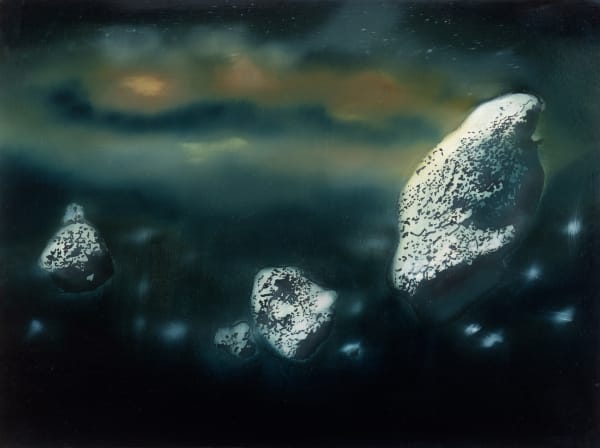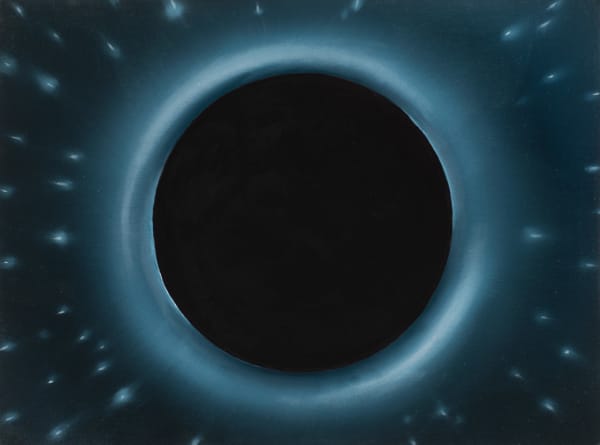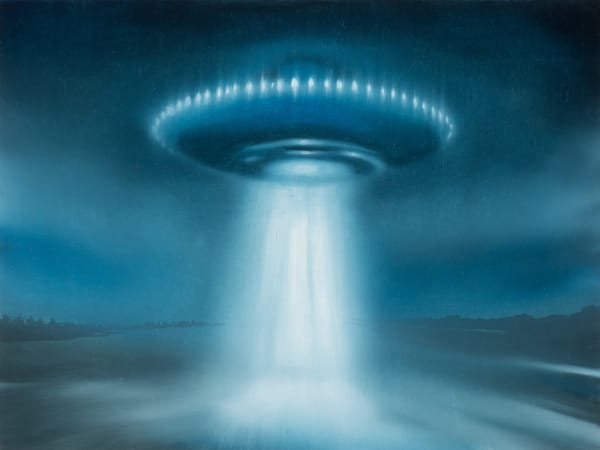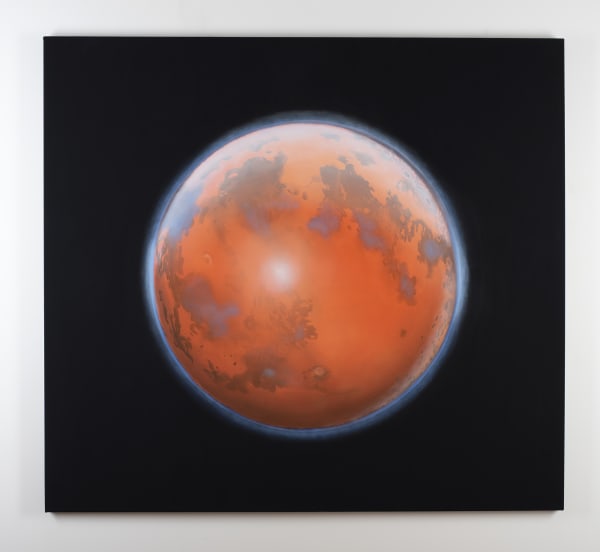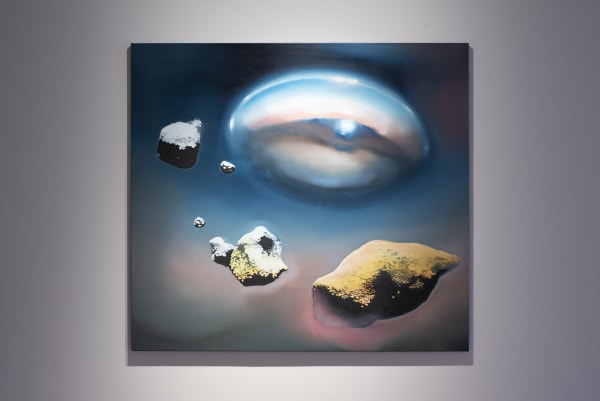Megan Walch: uncanny
There are, and have always been, things going on that we don’t know about.
William Kentridge says, “The one thing that Covid-19 has shown us is that claims to authoritative certainty about how the world operates are very thinly based. The question of uncertainty, ambiguity, and doubt is the bedrock of what happens in the studio whether you’re a writer, a singer, or visual artist.”[1]
When painting wet-on-wet there is a window of time in which to work with the fluid medium. In this moment you either capture or kill the image: you can infuse it with light and luminosity or make a dull muddy mess. This painting process allows for the unknown or indeterminate to enter the work and here it invades literally as flying saucers.
Painting flying saucers arose from my need to escape reality and have fun in the studio. As I searched the galaxy of Google images of UFOs mocked-up from saucepan lids and jelly moulds, cannibalised from old appliances and doctored in Photoshop, I was sucked into a vortex, a black hole of rumour, myth and conspiracy. I felt naughty, subversive; it left me vulnerable to ridicule.
Carl Jung proposes that, regardless of whether or not they exist, UFOs are the psychological products of humanity in crisis - projections of grief and psychic distress onto objects in “situations of collective angst, danger and vital need,” suggesting that during dark times they operate as symbols laden with Salvationist fantasies. He claims their round bodies are subconscious totems representing aspirations to unity or wholeness. [2]
In the past I’ve painted ellipses [3] to connote eccentricity in a pictorial world; discs that spin and glint have recurred in my paintings for ‘aeons’; these lozenges have been central characters within a whimsical visual language. On another level these works are simply about how to represent mass, volume and weight in paint and in two dimensions. Kinetically UFOs are erratic, they appear and disappear in an instant just as water droplets condense into liquid from a gaseous state.[4] Are they coming or going? Are they menacing or benign? For the first time many the forms in these paintings slow down to hang and hover in space, this is a surprise as vectors of energy have always been more interesting to me than objects.
It feels like a nostalgic form of futurism to depict 1950’s WearEver saucepan lids dipping and diving over misty mountain ranges and deserted highways - a familiar whimsical unknown, as distinct from current forms of manipulation and fear mongering: the disclosure of secrets that have long been concealed and trafficked in stealth: scandals, corruption, declassified UPAs and asteroids on collision courses - secrets leaked and brought to light after being sealed in darkness.
Painting is a vehicle for light - a ‘niche for lights”[5] and Art is a platform for ‘other’ kinds of knowing and being – it is a field in which the uncertain future may land. Uncannily, at the time I began this body of work and ‘alien’ was invading mine, reminding me that we too are visitors here for a relatively short time.
Meg 2022
[1] https://news.artnet.com/art-world/william-kentridge-2022534 accessed 11th
April 2022
[2] Jung, C. G. Flying Saucers, New York: MJF Books, 1996. P 22
[3] An ellipse is a circle or orbit whose axis is not placed centrally. Eccentricity is the quality of being abnormally centred; of not being concentric; of not having the axis in the centre. The quality or habit of deviating from what is usual or regular; irregularity, oddity, whimsicality.
Oxford English Dictionary, "Eccentricity, N." , accessed 11th April, 2022, http://www.oed.com/view/Entry/59249?redirectedFrom=eccentricity.
[4] Jung, C. G. Flying Saucers, New York: MJF Books, 1996. P 29.
[5] Walch’s first 1994 exhibition, Bett Gallery, “ A Niche for Lights” from translated Sufi texts reflecting on sources of light and levels of illumination.
-
 Megan WalchLaunching or Landing, 2023oil on canvas90 x 110cmAU$ 5,700.00
Megan WalchLaunching or Landing, 2023oil on canvas90 x 110cmAU$ 5,700.00 -
 Megan WalchClearing, 2022acrylic and oil on wood panel30 x 40cmSold
Megan WalchClearing, 2022acrylic and oil on wood panel30 x 40cmSold -
 Megan WalchCloaking, 2022acrylic and oil on wood panel40 x 30cm
Megan WalchCloaking, 2022acrylic and oil on wood panel40 x 30cm -
 Megan WalchCloaking 2, 2022acrylic and oil on wood panel30 x 40cmSold
Megan WalchCloaking 2, 2022acrylic and oil on wood panel30 x 40cmSold -
 Megan WalchCavalry, 2022acrylic and oil on wood panel40 x 70cm
Megan WalchCavalry, 2022acrylic and oil on wood panel40 x 70cm -
 Megan WalchAstroid Eros, 2022acrylic and oil on wood panel30 x 30cmAU$ 1,670.00
Megan WalchAstroid Eros, 2022acrylic and oil on wood panel30 x 30cmAU$ 1,670.00 -
 Megan WalchAstroid Bennu, 2022acrylic and oil on wood panel25 x 30cmSold
Megan WalchAstroid Bennu, 2022acrylic and oil on wood panel25 x 30cmSold -
 Megan WalchAsteroid 951 Gaspra, 2022acrylic and oil on wood panel25 x 30cmSold
Megan WalchAsteroid 951 Gaspra, 2022acrylic and oil on wood panel25 x 30cmSold -
 Megan WalchAlien invasion to your right, 2022acrylic and oil on wood panel30 x 40cmSold
Megan WalchAlien invasion to your right, 2022acrylic and oil on wood panel30 x 40cmSold -
 Megan WalchAlien invasion on your left, 2022acrylic and oil on wood panel30 x 40cmSold
Megan WalchAlien invasion on your left, 2022acrylic and oil on wood panel30 x 40cmSold -
 Megan WalchAirwalk: Did the object appear to stand still at any time?, 2022acrylic and oil on wood panel40 x 30cmAU$ 1,670.00
Megan WalchAirwalk: Did the object appear to stand still at any time?, 2022acrylic and oil on wood panel40 x 30cmAU$ 1,670.00 -
 Megan WalchDid the object appear to flicker, throb or pulsate?, 2022acrylic and oil on wood panel30 x 40cmAU$ 1,670.00
Megan WalchDid the object appear to flicker, throb or pulsate?, 2022acrylic and oil on wood panel30 x 40cmAU$ 1,670.00 -
 Megan WalchDid the object appear to follow you?, 2022acrylic and oil on wood panel46 x 76cm
Megan WalchDid the object appear to follow you?, 2022acrylic and oil on wood panel46 x 76cm -
 Megan WalchDid the object appear to give off smoke?, 2022oil on canvas90 x 112cm
Megan WalchDid the object appear to give off smoke?, 2022oil on canvas90 x 112cm -
 Megan WalchDid the object break into parts or explode?, 2022acrylic and oil on wood panel46 x 76cm
Megan WalchDid the object break into parts or explode?, 2022acrylic and oil on wood panel46 x 76cm -
 Megan WalchDid the object change brightness?, 2022acrylic and oil on wood panel30 x 40cmSold
Megan WalchDid the object change brightness?, 2022acrylic and oil on wood panel30 x 40cmSold -
 Megan WalchDid the object change shape?, 2022acrylic and oil on wood panel30 x 40cmSold
Megan WalchDid the object change shape?, 2022acrylic and oil on wood panel30 x 40cmSold -
 Megan WalchDid the object give off smoke?, 2022acrylic and oil on wood panel40 x 30cm
Megan WalchDid the object give off smoke?, 2022acrylic and oil on wood panel40 x 30cm -
 Megan WalchDid the object move in front of something at anytime, particularly a cloud?, 2022acrylic and oil on wood panel30 x 40cm
Megan WalchDid the object move in front of something at anytime, particularly a cloud?, 2022acrylic and oil on wood panel30 x 40cm -
 Megan WalchDid the object suddenly speed up or rush away at anytime?, 2022acrylic and oil on wood panel30 x 40cmSold
Megan WalchDid the object suddenly speed up or rush away at anytime?, 2022acrylic and oil on wood panel30 x 40cmSold -
 Megan WalchDull daylight, 2022acrylic and oil on wood panel30 x 40cmSold
Megan WalchDull daylight, 2022acrylic and oil on wood panel30 x 40cmSold -
 Megan WalchEarth Grazers, 2022acrylic and oil on wood panel30 x 40cmAU$ 1,670.00
Megan WalchEarth Grazers, 2022acrylic and oil on wood panel30 x 40cmAU$ 1,670.00 -
 Megan WalchEarth Grazers, 2022oil on canvas153 x 168cm
Megan WalchEarth Grazers, 2022oil on canvas153 x 168cm -
 Megan WalchFilter Bubble, 2022oil on wood panel25 x 30cmSold
Megan WalchFilter Bubble, 2022oil on wood panel25 x 30cmSold -
 Megan WalchJust a Trace of Daylight, 2022oil on canvas138 x 168cm
Megan WalchJust a Trace of Daylight, 2022oil on canvas138 x 168cm -
 Megan WalchJust a trace of daylight, 2022acrylic and oil on wood panel30 x 40cmSold
Megan WalchJust a trace of daylight, 2022acrylic and oil on wood panel30 x 40cmSold -
 Megan WalchJust as water droplets condense into liquid from a gaseous state, 2022acrylic and oil on wood panel30 x 40cmSold
Megan WalchJust as water droplets condense into liquid from a gaseous state, 2022acrylic and oil on wood panel30 x 40cmSold -
 Megan WalchJust as water droplets condense into liquid from a gaseous state, 2022oil on canvas152 x 168cmAU$ 9,400.00
Megan WalchJust as water droplets condense into liquid from a gaseous state, 2022oil on canvas152 x 168cmAU$ 9,400.00 -
 Megan WalchM87 (blue), 2022acrylic and oil on wood panel30 x 40cm
Megan WalchM87 (blue), 2022acrylic and oil on wood panel30 x 40cm -
 Megan WalchM87 (red), 2022acrylic and oil on wood panel30 x 40cm
Megan WalchM87 (red), 2022acrylic and oil on wood panel30 x 40cm -
 Megan WalchNo trace of daylight, 2022acrylic and oil on wood panel30 x 40cmSold
Megan WalchNo trace of daylight, 2022acrylic and oil on wood panel30 x 40cmSold -
 Megan WalchOumuamua, 2022acrylic and oil on wood panel30 x 40cmAU$ 1,670.00
Megan WalchOumuamua, 2022acrylic and oil on wood panel30 x 40cmAU$ 1,670.00 -
 Megan Walch, Strawberry Moon, 2022
Megan Walch, Strawberry Moon, 2022 -
 Megan WalchStrawberry Moon, 2022oil and black 3.0 on canvas153 x 168 cmSold
Megan WalchStrawberry Moon, 2022oil and black 3.0 on canvas153 x 168 cmSold -
 Megan WalchWas the object brighter than the background of the sky?, 2022acrylic and oil on wood panel30 x 40cmAU$ 1,670.00
Megan WalchWas the object brighter than the background of the sky?, 2022acrylic and oil on wood panel30 x 40cmAU$ 1,670.00 -
 Megan WalchWearEver, 2022oil on canvas127 x 168cm
Megan WalchWearEver, 2022oil on canvas127 x 168cm






















